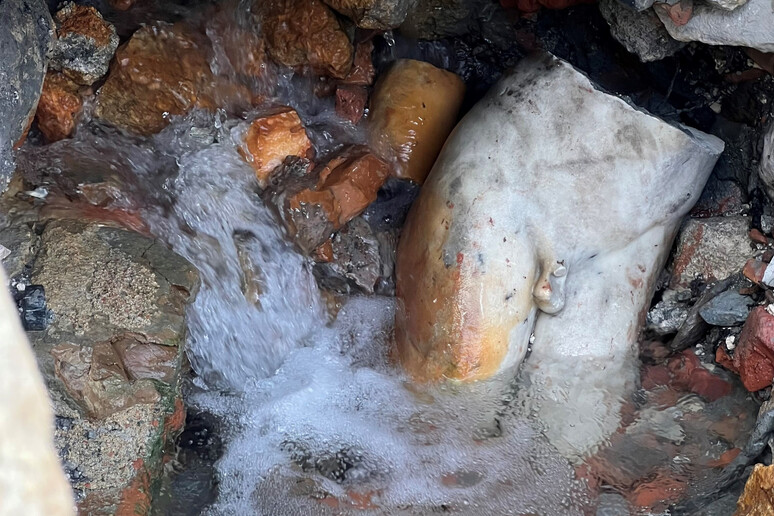(by ANSA correspondent Silvia
Lambertucci)
A youthful Apollo, elegant and beautiful, intent on hunting a
lizard.
After last year's wonder of the bronzes, this statue is larger,
monumental even, almost two metres tall, a marble copy of a
bronze original by the famed Greek sculptor Praxiteles.
It is the latest treasure that has re-emerged from the mud and
boiling water of the excavations at San Casciano.
An extraordinary find, Professor Jacopo Tabolli of Siena's
University for Foreigners tells ANSA in an exclusive preview,
which is accompanied by a highly distinctive stone 'donarium'
(part of temple where votive offerings were laid) with a
bilingual inscription and myriad small objects in bronze,
terracotta and even glass that offer fascinating glimpses of the
daily life at the shrine.
"The San Casciano dig shows no signs of stopping amazing us,"
applauds the director general of archaeology at the culture
ministry, Luigi La Rocca.
And that's not all. Because if you widen the perimeter of the
excavation, what had at first appeared to be a small sacred
building constructed around the spring and its ritual bath has
turned out to be, over the last few months, a fully fledged
temple with an ornate portico featuring four columns and a
central part with a large bath partly covered by a dais
decorated with large statues, one of which was perhaps actually
that of the young Apollo.
A little jewel of monumental architecture and hydraulic
engineering, in short, built, in total continuity of cult, above
an older Etruscan sacellum (small chapel), the splendid walls of
which have been uncovered over the last few months. Even though
the Romans, perhaps precisely to make their temple more stable,
decided to adjust the orientation on the ground, slightly
rotating it, after enlarging and making more sumptuous the bath
destined to receive the offerings.
"(This is) further proof of the sacred value that was given here
to the hot water of the spring, which was felt to be a divinity
that bubbled up from the earth and which had its home in this
temple," stresses Tabolli, pointing out the limber limbs of the
large statue, which has just been entrusted to the care of the
restorers.
The emotion is strong, even though, unlike the bronzes on show
today at the Quirinal Palace which came to us intact, this
Apollo is sadly broken into pieces, some of which, like the arms
and parts of the head, still have to be found.
"It was no accident; this statue was deliberately broken and
then thrown into the bath right at the moment of the definitive
closure of the site, in the fifth century AD, and it's hard to
say whether (that happened) in a final pagan ritual, of
protection, or according to the iconoclastic wishes of
Christians," says the director of the digs, archaeologist
Emanuele Mariotti, indicating the point where the impetuous
force of the water, which now erupts at 30 litres per second,
has led to the discovery of the god's splendid legs.
"They were hidden by a column that was dropped vertically with
the precise intention of closing off and sealing everything,"
he explains, "and when we found them in front of us it was
crazy. Behind the legs, diving head-long, there emerged the bust
and then a small altar, in an incredible sequence".
It was a thrill that for some aspects was even greater than that
felt a year ago, when the bronzes were pulled out of this mud
and water.
"In our arms that marble body was so warm it seemed alive,"
thrills Tabolli again.
Because albeit in pieces, the archaeologists underline, who also
in this case shared the discovery with a extensive network of
experts, the Apollo of San Casciano has huge scientific
interest.
Of Praxiteles's statue, whose original is perhaps a bronze work
held in Cleveland, various Roman marble copies exist that are on
show in the world's museums, the most famous in the Louvre and
the Vatican Museums.
But not one is linked to a precise context, just as there is no
myth explaining the significance of the god's game with the
lizard.
"And here, on the other hand, that very link may be established
and it may be with medicine," Tabolli says, "seeing that the
lizard for the ancients was linked to ophthalmic cures and that
exemplars of bronze lizards have been found in the bath".
Apollo, in other words, may have played an important role in
this Tuscan temple where the ancients came to be treated, with
the statue venerated and paid obeisance to together with the
water gods precisely for his link with medicine and the health
cures that were practised here.
"We are also thinking about that other Apollo, the bronze one we
found a year ago. And then about the various altars dedicated to
the god," Tabolli points out.
"The tutelary deity of the water, a great protagonist of a
history of disease and recovery, of anxieties and refound hopes,
goes back seven centuries here".
ALL RIGHTS RESERVED © Copyright ANSA











